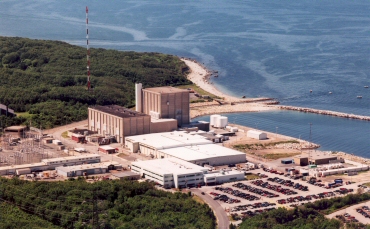I have often mentioned that the spent fuel pools at nuclear reactors in the U.S. are filling up. If temporary dry cask storage is not quickly build so some fuel assemblies can be removed from the pools, some reactors will have to be shut down. Unfortunately, current designs for dry casks have serious problems that need to be corrected before those fuel assemblies can be safely stored. Eventually, the U.S. government expects to have a geological repository for spent nuclear fuel but such a repository will not be available before 2050 at the earliest.
The Pilgrim Nuclear Power Station started producing electricity for the grid in 1972. It was based on an antiquated design from the 1950s. One serious problem was the fact thatheir it was known that if there was a serious nuclear accident, the containment vessel would not be able to prevent radioactive materials from escaping. Another problem with the design was that it called for putting the spent fuel cooling pool inside the reactor building.
Every eighteen months, one third of the fuel rods in the reactor become too hot with radiation to be controlled inside the reactor. They have to be removed and placed in the spent fuel pool under forty feet of water so they can spend years cooling down. If the rods are exposed to the air in a failure of the cooling system, they can burst into flames. Such a fire would release large amounts to radioactive materials into the environment because of the problem with the containment vessel mentioned above.
The spent fuel pool at the Pilgrim plant was designed to hold eight hundred and eighty fuel rod assemblies. There are now more than three thousand assemblies in the pool. The Pilgrim plant is scheduled to be permanently shut down in 2019. Highly radioactive fuel rods will have to remain in the spent fuel pool for many years after the shutdown to cool off sufficiently to be handled. Because there won't be a national repository for spent fuel before 2050, the fuel assemblies will have to be stored onsite in dry casks until they can be moved to a new national repository. The casks have problems but they are safer than the spent fuel pool.
Entergy, the operators of the Pilgrim plant, has constructed three dry casks for fuel assembly storage. They will have to construct another hundred casks to accept all the spent fuel assemblies in the spent fuel cooling pool. The casks are in what is called the "Independent Spent Fuel Storage Installation. " (ISFSI) No governmental agency from the local to the federal level reviewed and authorized the location of the ISFSI which is one hundred and twenty feet from Cape Cod Bay and is only a few feet above the flood zone. A group of citizens in the area has filed a lawsuit against the Plymouth Zoning Board of Appeals decision which allowed the construction of the ISFSI in that location.
There are about one hundred nuclear power reactors in the U.S. now. Many of them are reaching the limit for storing fuel assemblies in the cooling pools. As more and more dry casks are build and deployed to take these spent fuel assemblies, the problems with the dry casks may lead to accidents that result in the release of radioactive materials.
Pilgrim Nuclear Power Station:
